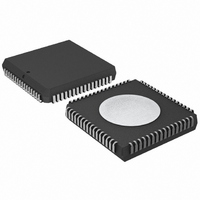P80C592FFA/00,512 NXP Semiconductors, P80C592FFA/00,512 Datasheet - Page 57

P80C592FFA/00,512
Manufacturer Part Number
P80C592FFA/00,512
Description
IC 80C51 MCU 8BIT ROMLESS 68PLCC
Manufacturer
NXP Semiconductors
Series
80Cr
Datasheet
1.P80C592FFA00512.pdf
(108 pages)
Specifications of P80C592FFA/00,512
Program Memory Type
ROMless
Package / Case
68-PLCC
Core Processor
8051
Core Size
8-Bit
Speed
16MHz
Connectivity
CAN, EBI/EMI, UART/USART
Peripherals
DMA, POR, PWM, WDT
Number Of I /o
48
Ram Size
512 x 8
Voltage - Supply (vcc/vdd)
4.5 V ~ 5.5 V
Data Converters
A/D 8x10b
Oscillator Type
Internal
Operating Temperature
-40°C ~ 85°C
Processor Series
P80C5x
Core
80C51
Data Bus Width
8 bit
Data Ram Size
512 B
Interface Type
CAN/UART
Maximum Clock Frequency
16 MHz
Number Of Programmable I/os
40
Number Of Timers
3
Maximum Operating Temperature
+ 85 C
Mounting Style
SMD/SMT
3rd Party Development Tools
PK51, CA51, A51, ULINK2
Minimum Operating Temperature
- 40 C
On-chip Adc
8-ch x 10-bit
Cpu Family
80C
Device Core
80C51
Device Core Size
8b
Frequency (max)
16MHz
Program Memory Size
Not Required
Total Internal Ram Size
512Byte
# I/os (max)
40
Number Of Timers - General Purpose
3
Operating Supply Voltage (typ)
5V
Operating Supply Voltage (max)
5.5V
Operating Supply Voltage (min)
4.5V
Instruction Set Architecture
CISC
Operating Temp Range
-40C to 85C
Operating Temperature Classification
Industrial
Mounting
Surface Mount
Pin Count
68
Package Type
PLCC
Lead Free Status / RoHS Status
Lead free / RoHS Compliant
Eeprom Size
-
Program Memory Size
-
Lead Free Status / Rohs Status
Compliant
Other names
568-1241-5
935086530512
P80C592FFAA
935086530512
P80C592FFAA
Available stocks
Company
Part Number
Manufacturer
Quantity
Price
Company:
Part Number:
P80C592FFA/00,512
Manufacturer:
ON
Quantity:
300
Company:
Part Number:
P80C592FFA/00,512
Manufacturer:
NXP Semiconductors
Quantity:
10 000
Philips Semiconductors
13.6.3
A CAN-controller acting as a receiver for certain
information may initiate the transmission of the respective
data by transmitting a Remote Frame to the network,
addressing the data source via the Identifier and setting
the RTR bit HIGH (remote; recessive bus level). The
Remote Frame is similar to the Data Frame with the
following exceptions:
Note that the value of the Data Length Code should be the
one of the corresponding Data Frame, although it is
ignored for a Remote Frame.
A Remote Frame is composed of six different bit fields:
See Section 13.6.2 for more detailed explanation of the
Remote Frame bit fields.
13.6.4
The Error Frame consists of two different fields:
13.6.4.1
There are two forms of an Error Flag:
An error-active CAN-controller (see Section 13.6.9)
detecting an error condition signals this by transmission of
an Active Error Flag. This Error Flag's form violates the
bit-stuffing rule (see Section 13.6.7) applied to all fields,
1996 Jun 27
RTR bit is set HIGH
Data Length Code is ignored
No Data Field contained.
Start-of-Frame
Arbitration Field
Control Field
CRC Field
Acknowledge Field
End-Of-Frame.
The first field, accomplished by the superimposing of
Error Flags contributed from different CAN-controllers
The second field is the Error Delimiter.
Active Error Flag, consists of six consecutive
dominant bits.
Passive Error Flag, consists of six consecutive
recessive bits unless it is overwritten by dominant bits
from other CAN-controllers.
8-bit microcontroller with on-chip CAN
R
E
RROR
EMOTE
Error Flag
F
F
RAME
RAME
57
from Start-Of-Frame to CRC Delimiter, or destroys the
fixed form of the fields Acknowledge Field or
End-Of-Frame (see Fig.20).
Consequently, all other CAN-controllers detect an error
condition and start transmission of an Error Flag.
Therefore the sequence of dominant bits, which can be
monitored on the bus, results from a superposition of
different Error Flags transmitted by individual
CAN-controllers. The total length of this sequence varies
between six (minimum) and twelve (maximum) bits.
An error-passive CAN-controller (see Section 13.6.9)
detecting an error condition tries to signal this by
transmission of a Passive Error Flag. The error-passive
CAN-controller waits for six consecutive bits with identical
polarity, beginning at the start of the Passive Error Flag.
The Passive Error Flag is complete when these six
identical bits have been detected.
13.6.4.2
The Error Delimiter consists of eight recessive bits and has
the same format as the Overload Delimiter. After
transmission of an Error Flag, each CAN-controller
monitors the bus-line until it detects a transition from a
dominant-to-recessive bit level. At this point in time, every
CAN-controller has finished sending its Error Flag and has
additionally sent the first out of the 8 recessive bits of the
Error Delimiter. Afterwards all CAN-controllers transmit the
remaining recessive bits. After this event and an
Intermission Field all error-active CAN-controllers within
the network can start a transmission simultaneously.
If a detected error is signalled during transmission of a
Data Frame or Remote Frame, the current message is
spoiled and a retransmission of the message is initiated.
If a CAN-controller monitors any deviation of the Error
Frame, a new Error Frame will be transmitted. Several
consecutive Error Frames may result in the CAN-controller
becoming error-passive and leaving the network
unblocked.
In order to terminate an Error Flag correctly, an
error-passive CAN-controller requires the bus to be
Bus-Idle (see Section 13.6.6) for at least three bit periods
(if there is a local error at an error-passive-receiver).
Therefore a CAN-bus should not be 100% permanently
loaded.
Error Delimiter
Product specification
P8xC592















